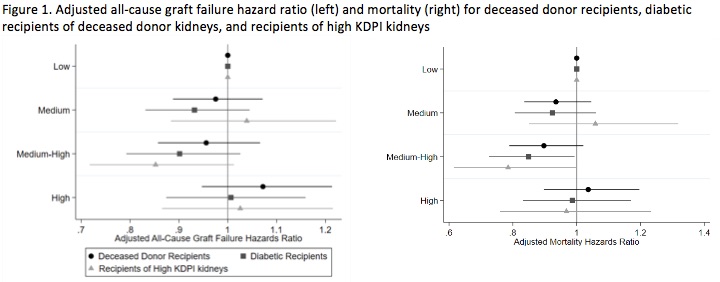The Association of Kidney Transplant Center Volume with 3-Year Outcomes
1Surgery, University of Pennsylvania, Philadelphia, PA, 2Renal Division, University of Pennsylvania, Philadelphia, PA, 3Biostatistics, University of Pennsylvania, Philadelphia, PA
Meeting: 2019 American Transplant Congress
Abstract number: B143
Keywords: Donors, marginal, Elderly patients, Kidney transplantation, Outcome
Session Information
Session Name: Poster Session B: Kidney Donor Selection / Management Issues
Session Type: Poster Session
Date: Sunday, June 2, 2019
Session Time: 6:00pm-7:00pm
 Presentation Time: 6:00pm-7:00pm
Presentation Time: 6:00pm-7:00pm
Location: Hall C & D
*Purpose: To assess if a center volume-outcome relationship exists for contemporary kidney transplantation, specifically in increased-risk scenarios including: diabetic recipients, elderly recipients (age>65) or recipients of high kidney donor profile index (KDPI) >85 kidneys.
*Methods: Using UNOS data from 2009-2013, 219 kidney transplant centers performing 79,581 kidney transplants were analyzed. Centers were categorized into quartiles (low, medium, medium-high, high) based on the total kidney transplant volume, including both deceased and living donor transplants, for the period. Low-quartile centers performed a mean of <66 kidney transplants/year, whereas high-quartile centers performed a mean of >196 kidney transplants/year.
*Results: The characteristics of deceased donor recipients varied slightly between volume quartiles; grafts at high-quartile centers had longer cold ischemia time (Table 1).
We observed minor differences in the rates of 3-year deceased donor all-cause graft failure across quartiles (overall: low-quartile centers=14.9% vs. high-quartile centers=16.7%) (supgroups: diabetic recipients at low-quartile centers=18.4% vs. high-quartile centers=19.7%; elderly recipients at low-quartile-centers=19.4% vs. high-quartile centers=22.4%; high KDPI recipients at low-quartile centers=26.5% vs. high-quartile centers=26.5%). Results were similar for 3-year mortality. Adjusting for donor, recipient and graft characteristics using Cox models, center volume was not significantly associated with all-cause graft failure or mortality within 3 years, except that diabetic recipients at medium-high centers had slightly lower mortality (aHR 0.85; 95%CI 0.73-0.99; p=0.041)[Figure 1].
*Conclusions: While unmeasured confounding is possible, these results provide little evidence that higher volume centers provide better outcomes for kidney transplant patients, even in populations anticipated to be at increased risk of graft failure or death.
To cite this abstract in AMA style:
Sonnenberg EM, Cohen JB, Hsu JY, Potluri VS, Levine MH, Abt PL, Reese PP. The Association of Kidney Transplant Center Volume with 3-Year Outcomes [abstract]. Am J Transplant. 2019; 19 (suppl 3). https://atcmeetingabstracts.com/abstract/the-association-of-kidney-transplant-center-volume-with-3-year-outcomes/. Accessed December 16, 2025.« Back to 2019 American Transplant Congress


